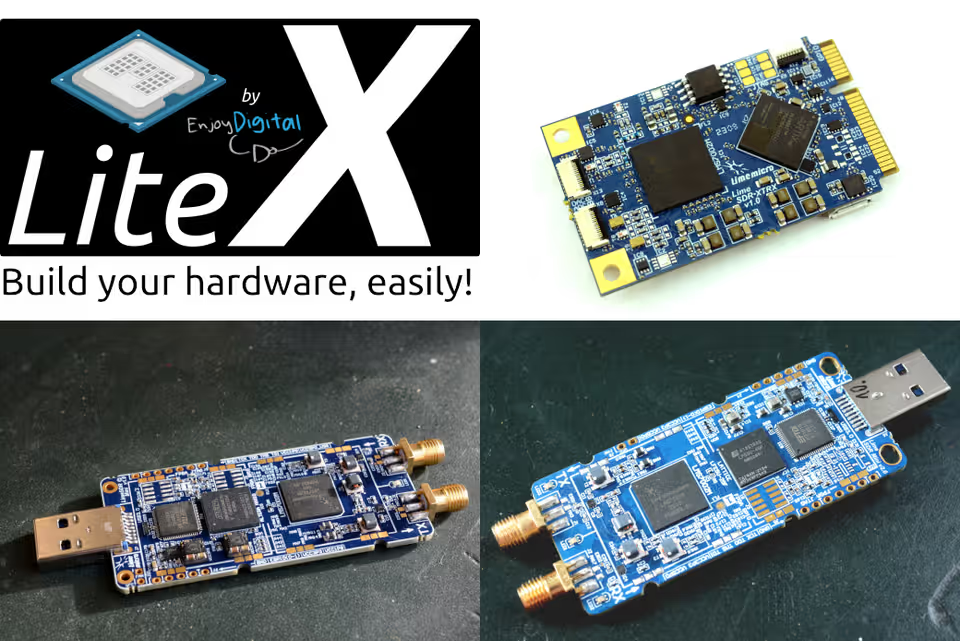
Lime Microsystems Announces New Unified SDR Gateware Platform
London UK, May 14th 2025 — Field-programmable radio-frequency technology leader Lime Microsystems is proud to announce the launch of the LimeSDR GW Project, a collaboration with Enjoy Digital to migrate its LimeSDR product line to a new, more accessible, fully unified and portable gateware built atop the LiteX framework.
The popular open-source LimeSDR family of software-defined radio products, including the LimeSDR Mini family and the LimeSDR XTRX, feature field-programmable gate arrays (FPGAs) in addition to Lime Micro’s market-leading field-programmable radio-frequency integrated circuit (FP RFIC) technology. This provides them with extreme flexibility, including the ability to use spare FPGA capacity to run users’ custom workloads on-device — but the complexity and monolithic nature of earlier FPGA code, known as gateware, has set a relatively high barrier to entry for those looking to take advantage of this feature.
The LimeSDR GW Project, launched by Lime Micro in partnership with Enjoy Digital, aims to dramatically lower that barrier to entry. Designed to provide a single unified gateware for all LimeSDR products beginning with LimeSDR Mini v1 and v2, and the LimeSDR XTRX, with full portability between FPGA vendors including Intel Altera, AMD Xilinx, and Lattice Semiconductor, the LimeSDR GW Project uses a modular approach to development to improve accessibility, maintainability, and portability.
For certain boards, such as the LimeSDR Mini v2, a fully open-source toolchain is even available, leveraging tools including GHDL, Yosys, nextPNR, and openFPGALoader to enable a radically open development process and accelerate build iterations. Support for fully open-source toolchains is anticipated on other boards, such as the LimeSDR XTRX and LimeSDR Mini v1, through initiatives such as the openXC7 and Mistral projects, further enhancing the ecosystem’s openness and flexibility.
The new gateware is built atop Enjoy Digital’s open-source LiteX platform, combined with common building-block components known as Lime Digital Function Blocks (LimeDFB). In addition to making the underlying code more understandable, it also provides enhanced and more accessible extensibility — making it easier for users to implement custom features to run on LimeSDR hardware. This is showcased in the first of a planned series of demonstration projects, which uses spare FPGA capacity to implement a fast Fourier transform (FFT) algorithm on-device and without consuming any resources on the host computer.
“At Lime Micro, we’ve long expressed our desire to democratise radio access infrastructure with our field-programmable RFIC products and LimeSDR devices,” says Ebrahim Bushehri, Lime Micro’s chief executive officer, of the new project. “This partnership with Enjoy Digital is a significant step forward in that mission, opening up the LimeSDR family for new use cases. We are eager to see what the community will do with the new gateware code, and look forward to seeing the implementation of new functionality we have never even considered — unlocking the true potential of our technology for all.”
The use of the LiteX framework in the LimeSDR GW Project is key to the ease with which new features and modules can be integrated, and will make it simpler for users to implement their own custom functionality. This also makes it possible to switch out the compute functionality on LimeSDR hardware, swapping between different soft-core central processing unit (CPU) blocks depending on user need. The initial release includes support for two well-known soft-core RISC-V CPUs, VexRiscv and PicoRV32, both of which are free and open-source.
“We developed LiteX at Enjoy Digital to meet our own needs while keeping it open-source so anyone can more easily create and maintain FPGA designs, from CPU cores to fully-featured SoCs. Our partnership with Lime Micro truly demonstrates its ability to simplify and scale real-world projects,” says Enjoy Digital’s Florent Kermarrec. “I hope our work together will give LimeSDR users the flexibility, accessibility, and portability they need to grow the ecosystem in new and exciting ways, and we’re thrilled to be a part of that.”
More information on the LimeSDR GW Project is available on the official project site, with source code published to GitHub under the permissive Apache 2.0 licence; a separate site provides information on the currently-available LimeDFB blocks, with their source code available in a dedicated GitHub repository under the same licence.